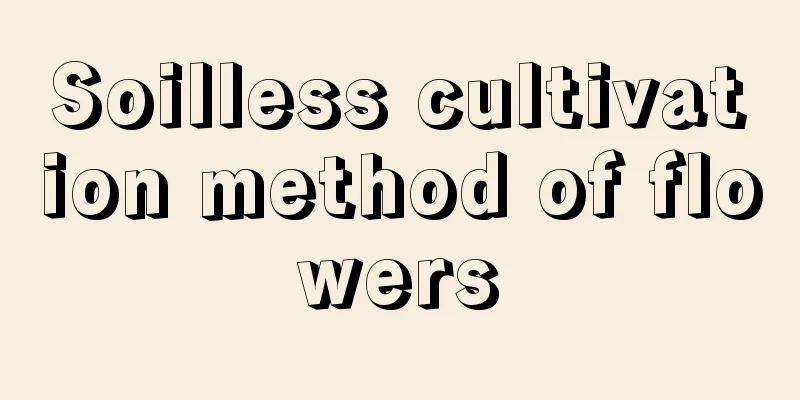Soilless cultivation method of flowers

What is soilless cultivationSome home gardeners in southern my country often soak the rootless stems of lucky bamboo in a vase. They will take root in about 10 days and grow well. After taking root, there is no need to plant them in potting soil. Some other flower plants, such as bamboo evergreen, can be cultivated and displayed using this method, which is called "hydroponics". Most people think that soilless cultivation is hydroponic flower cultivation, but this is not the case. Hydroponics is just one method of soilless cultivation. If you want to display plants for viewing, you must first fix the plants so that they can grow independently without falling over. This requires using granular cultivation substrates sold in flower shops or pea stone, perlite, etc. to fix the roots, and then inject water into them for cultivation. Commonly used methods include gravel culture, sand culture, leech culture, asbestos block culture, plastic particle culture, etc., collectively referred to as soilless culture. Advantages of soilless cultivationNo space restrictionsToday, as urban residences develop towards three-dimensional spaces, soilless cultivation is particularly suitable for growing flowers in small areas such as windowsills, balconies, hallways, and desks. Using soilless cultivation method to grow flowers can prevent the occurrence of underground pests and diseases, and there will be no odor due to fertilizing the potting soil. There is no need to prepare the culture soil, saving the trouble of loosening the soil, weeding and repotting. Flowers grow strongerWhat's more important is that the loss of nutrients in potting soil when planting flowers is as much as 40% - 60%. The nutrient loss of soilless cultivation generally does not exceed 10%. If cultivated properly, the growth of flowers and trees will generally be stronger than that of flowers and trees cultivated in potted soil. Soilless cultivation methodChoice of nutrient solutionWhen carrying out soilless cultivation in a flower farm, the nutrient solution is prepared according to the different needs of various flowers and trees. The operation is quite complicated and involves many issues, such as the composition of nutrients, the concentration of the nutrient solution, the effectiveness of nutrients, the consumption and supplementation of nutrients, and pH testing, etc. When home gardeners conduct soilless cultivation, they do not have the conditions or the need to prepare the nutrient solution by themselves, so they can just buy ready-made ones! Replacement of nutrient solutionNutrient elements in the flower container will gradually oxidize and photochemically change, and the pH balance will become unbalanced, so they should be replaced in time. Indoor flowers should be replaced every 3-4 days. When replacing, the cultivation medium must be thoroughly rinsed with clean water, and then new nutrient solution diluted with water is injected, otherwise the water concentration will become higher and higher. |
<<: How to manage Dieffenbachia in winter
Recommend
How to care for Jasmine potted plants
1. Choice of pots and soil People who know it kno...
Does Kalanchoe need a large or small pot? How to choose the size of the pot?
Kalanchoe is a plant with a relatively shallow ro...
3 ways to make your own fertilizer for flowers at home (tips for making your own fertilizer for flowers at home)
Fermented orange peel water as flower fertilizer ...
How often should I water the pearl bush?
How often should I water the pearl bush? The freq...
These 4 types of gardens are all so beautiful that you would be satisfied with just one in your lifetime!
Exquisite terrace garden For friends who live in ...
Diseases and Pests of Lilium and Their Control
Diseases of Lilium and their control powdery mild...
How to grow tiger skin plant
1. Light When caring for Sansevieria indoors, you...
Which month is the best time to plant beans?
This kind of beans is not that kind of beans. Man...
The difference between Berberis rubrum and Loblollyia chinensis
1. Difference of blades The leaves of Berberis ru...
Platycodon cultivation methods and precautions
How to cultivate Platycodon grandiflorum Choice o...
Does the Australian fir bloom?
1. No flowering It will not bloom. Although it ca...
Clivia growth environment conditions and characteristics
Clivia growth environment conditions and requirem...
When does the cardinal coral bloom?
Flowering period of red cardinal coral The flower...
Why do Phalaenopsis stems turn yellow? How to treat stem rot?
1. Why do Phalaenopsis orchid stems turn yellow? ...
How to propagate Aloe Vera and what to pay attention to
How to reproduce Aloe vera The main propagation m...









